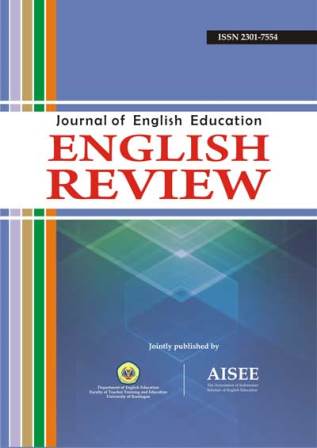BETWEEN REALITY AND IDEALISM: DOES NOVEL READING GENERATE EMPATHY IN ALGERIAN EFL STUDENTS?
Abstract
This study is an exploration of the extent to which reading novels develops Algerian EFL students’ empathetic attitudes towards human issues in the novel they are exposed to on the one hand and towards current local and worldwide issues on the other. To achieve this aim, a survey questionnaire is designed. The respondents are 50 MA students of Anglo-American Studies at the English Department of Oum El Bouaghi University (Algeria). The students have been exposed to Mark Twain’s The Adventures of Huckleberry Finn as a part of their syllabus. Accordingly, their reactions to the questions concerning this novel provide the necessary data around which this study hinges. The findings of the research are meant to help teachers and researchers to seek out new possibilities of developing more effective ways of using novel reading in EFL university classes. Additionally, the results serve to raise Algerian EFL students’ awareness about reading novels and their impact on stimulating their imagination, critical thinking and emotional attitudes.
Keywords:Â EFL teaching/ learning, novel, narrative empathy, empathetic attitudes, critical thinking, Algeria.
References
Bal, P. M. & Veltkamp, M. (2013). How Does fiction reading influence empathy? An experimental investigation on the role of emotional transportation. Plos One, 8 (1): e55341. DOI: 10.1371/journal.pone.0055341
Collie, J., & Slater, S. (1987). Literature in the Language Classroom. Cambridge: Cambridge University Press.
Helton, C. A, Asamani, J., & Thomas, E. D. (1998). A ‘Novel’ approach to the teaching of reading. Tennessee State: Tennessee State University, 1-5. [Online] Retrieved from http: // www.nade.net / documents / SCP98 / SCP98.19.pdf
Keen, S. (2007). Empathy and the Novel. New York: Oxford University Press.
Lazar, G. (1993). Literature and Language Teaching: A Guide for Teachers and Trainers. Cambridge: Cambridge University Press.
Leake, E. (2014). Humanizing the inhumane: The value of difficult empathy. In M. M. Hammond & S. J. Kim (Eds.), Rethinking Empathy through Literature (pp. 175-185). New York: Routledge.
Nussbaum, M. C. (1997). Cultivating Humanity: A Classical Defense of Reform in Liberal Education. Cambridge, USA: Harvard University Press.
Stansfield, J., & Bunce, L. (2014). The relationship between empathy and reading fiction: Separate roles for cognitive and affective components. Journal of European Psychology Students, 5(3): 9-18. DOI: http://dx.doi.org/10.5334/jeps.ca
Widdowson, H. G. (1975). Stylistics and the Teaching of Literature. London: Longman.
Zunshine, L. (2006). Why We Read Fiction: Theory of Mind and the Novel. Columbus: Ohio State University Press.
All articles published in English Review: Journal of English Education (ERJEE) are licensed under the Creative Commons Attribution 4.0 International License (CC BY 4.0).
Copyright Ownership
Authors retain the copyright of their articles and grant ERJEE the right of first publication. The journal is granted a non-exclusive license to publish, reproduce, and distribute the article in any format, medium, or platform, provided that proper credit is given to the original authors.
License Terms – CC BY 4.0
Under the Creative Commons Attribution 4.0 International License, others are free to:
- Share — copy and redistribute the material in any medium or format
- Adapt — remix, transform, and build upon the material for any purpose, even commercially
As long as they:
- Provide appropriate credit to the original author(s) and source
- Provide a link to the license (https://creativecommons.org/licenses/by/4.0/)
- Indicate if any changes were made
There are no restrictions on the reuse, reproduction, or adaptation of published articles as long as attribution is properly given.
Author Warranties
By submitting a manuscript to ERJEE, authors confirm that:
- The work is original and does not infringe any existing copyright.
- The manuscript has not been previously published and is not under consideration elsewhere.
- All sources and references are appropriately acknowledged.
- Necessary permissions have been obtained for any copyrighted materials used.










